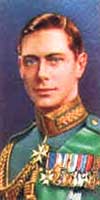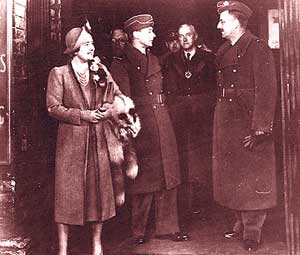
King George VI
George VI became king suddenly following the abdication of his brother, Edward VIII, in 1936. He worked hard to adapt to this unexpected role, particularly during the difficult years of World War Two. George was born on December 14, 1895 at Sandringham in Norfolk, the second son of the Duke of York, later George V. He was christened Albert after his great-grandfather, Prince Albert. In 1909, he went to Dartmouth Naval College and joined the Royal Navy – seeing action in the World War One Battle of Jutland – and then the Royal Air Force. In 1920, he was created Duke of York and began to take on royal duties. In 1923, he married Lady Elizabeth Bowes-Lyon, youngest daughter of the 14th Earl of Strathmore. They had two daughters, Elizabeth and Margaret. Following the abdication of his elder brother, King Edward VIII, George was proclaimed king on December 12, 1936 and crowned in May the following year. He and the queen paid state visits to France in 1938, and to Canada and the United States in 1939, making George the first British monarch to enter the US. George supported Prime Minister Chamberlain's policy of appeasement towards Germany and Italy. When Chamberlain resigned in May 1940, the king wished to replace him with Lord Halifax, but was persuaded to accept Winston Churchill, whose wartime leadership he then supported unreservedly.
During the war George visited Allied armies on several battle fronts and toured the home front extensively. He also founded the George Cross for 'acts of the greatest heroism or of the most conspicuous courage in circumstances of extreme danger,' usually by civilians. Although his symbolic leadership in Britain was crucial during World War Two, George's reign was perhaps most important for the accelerating evolution of the British Empire into the Commonwealth of Nations and the post-war transformation of Great Britain into a welfare state. His hereditary title of emperor of India ceased in 1947, when India and Pakistan became separate independent countries. From 1948, his health deteriorated, and he died on February 6, 1952, a few months after undergoing an operation for lung cancer. His elder daughter Elizabeth succeeded him as monarch. |
|
||||||
|| Front
Page | News
| Editorial
| Columns
| Sports
| Plus
| Financial
Times | International
| Mirror
| TV
Times | Funday
Times || |
| |
Reproduction of articles permitted when used without any alterations to contents and the source. |
© Copyright
2008 | Wijeya
Newspapers Ltd.Colombo. Sri Lanka. All Rights Reserved. |

